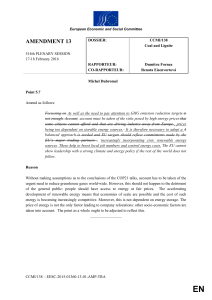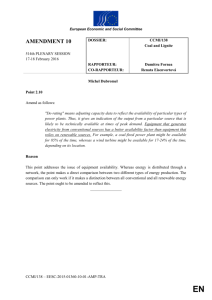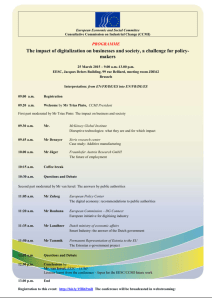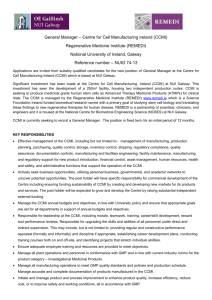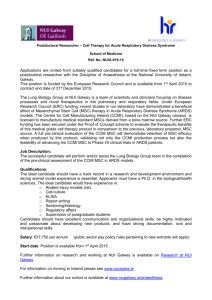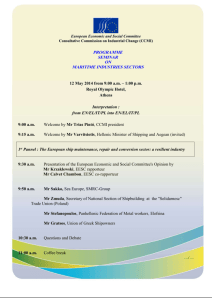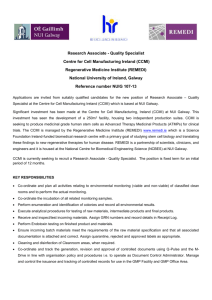Simplification - machinery sector(complementary opinion)
advertisement
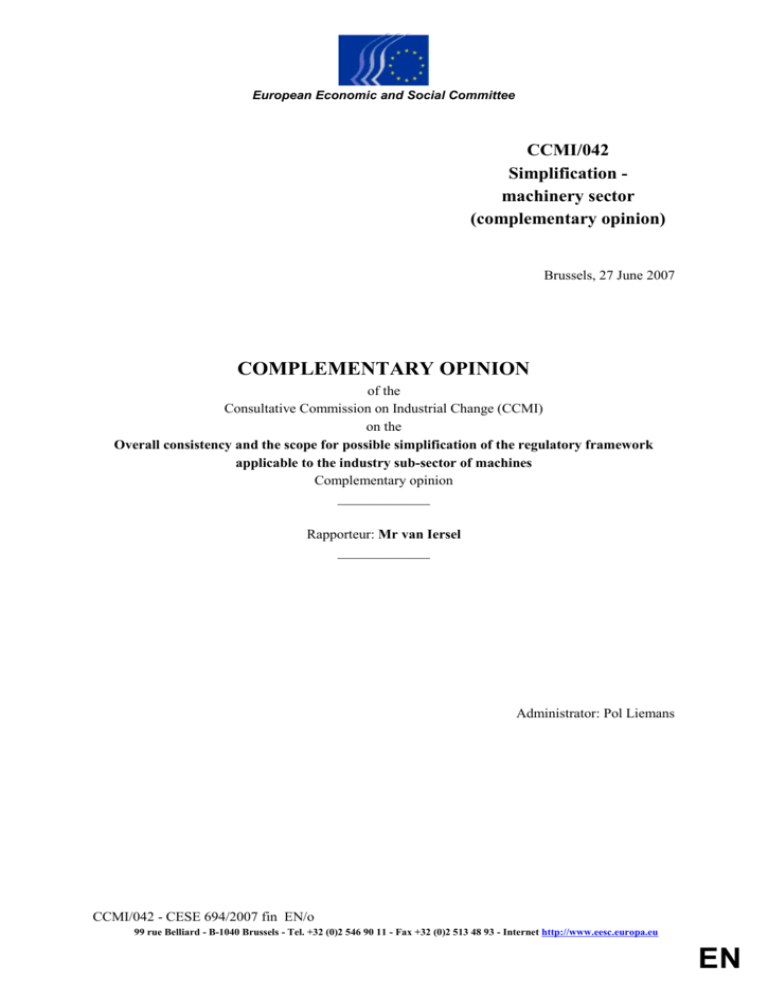
European Economic and Social Committee CCMI/042 Simplification machinery sector (complementary opinion) Brussels, 27 June 2007 COMPLEMENTARY OPINION of the Consultative Commission on Industrial Change (CCMI) on the Overall consistency and the scope for possible simplification of the regulatory framework applicable to the industry sub-sector of machines Complementary opinion _____________ Rapporteur: Mr van Iersel _____________ Administrator: Pol Liemans CCMI/042 - CESE 694/2007 fin EN/o 99 rue Belliard - B-1040 Brussels - Tel. +32 (0)2 546 90 11 - Fax +32 (0)2 513 48 93 - Internet http://www.eesc.europa.eu EN -1On 14 February 2007, the Bureau of the European Economic and Social Committee, acting under Rule 32(2) of its Rules of Procedure, decided to instruct the Consultative Commission on Industrial Change to draw up a complementary opinion to the exploratory opinion of the Section for the Single Market, Production and Consumption on The overall consistency and the scope for possible simplification of the regulatory framework applicable to the industry sub-sector of machines Complementary opinion. The Consultative Commission on Industrial Change adopted its complementary opinion on 20 June 2007. The rapporteur was Mr van Iersel. * * * 1. Conclusions and Recommendations 1.1 The CCMI welcomes wholeheartedly the priority of the Commission to (re-) examine the legislative process, to simplify EU law and to improve the acquis. "Implementation and enforcement" has to be considered as an integral part of "better lawmaking". All three have to be seen in a common perspective. 1.2 Consequently, the CCMI considers better lawmaking in a wider perspective, beyond simplification. Better lawmaking regarding individual sectors is to be seen as a component of industrial policy1. 1.3 The total package of about 70 Directives in the mechanical engineering sector is rather complete. Substantial problems arise by the way they are drafted as result of the legislative process, and are subsequently implemented. Not only the Commission, but also the European Parliament and the Member States have to take full responsibility for quality of EU-law. 1.4 The CCMI strongly endorses the ongoing practice of consultations and impact assessments. It insists on deepening these processes. Some instruments, such as the on-line consultation, make no sense. In general, the CCMI pleads for taking enough time. 1.5 The legal base (Arts. 175 and 95 of the Treaty) has often far-reaching implications from the conceptual phase of EU-legislation to final implementation and practice with consequences for the level playing field and innovation. The CCMI insists on better coordination and finetuning within the Commission as an indispensable first step. 1 Industrial policy implies, amongst others, impact assessments, focussed consultations, technological platforms, social dialogues, and also better lawmaking. CCMI/042 - CESE 694/2007 fin EN/o .../... -2- 1.6 Closer market surveillance is badly needed. The CCMI is in favour of an increased and reinforced role of the market authorities combined with a strong enforcement. Effective cooperation between national surveillance authorities is required. They are well placed for expost testing procedures and for a feedback in order to check the real impact of legislation. 1.7 The European Commission should intensify its efforts to reduce non-tariff barriers for machinery and equipment by actively promoting CRO2 and providing emerging countries with technical assistance to build up an efficient infrastructure for standardisation. 2. Reasons 2.1 The CCMI welcomes the invitation of Commissioners Wallström and Verheugen to draw up an exploratory opinion on Simplification of legislation regarding the sector Mechanical engineering. 2.2 The EESC has already expressed, in a former opinion3, the specific structure and dynamics of this sector. 2.3 The sector consists of tens of thousands of small and medium sized companies for which a level playing field is of crucial importance. Moreover, mechanical engineering is contributing largely to the infrastructure underpinning the European economy. It has a multiplier position, creating considerable employment, in particular for skilled and knowledge employees. 2.4 The CCMI prefers to discuss Better Lawmaking in this sector in a wider perspective beyond simplification, for the following reasons: 2.5 2 3 4 Better Lawmaking is a generic and clear criterion and implies simplification, clarity, reducing administrative burdens, as well as implementation. Better lawmaking is of overriding importance for the rule of law. It is also one of the tools to enhance trust among the actors in the market (and among citizens). It is essential for the creation of a level playing field in the EU, for innovation and for competitiveness across Europe. Lawmaking cannot be separated from effective transposition. Accordingly, this opinion discusses the whole legislative process and its effects, from the concept to the transposition, implementation and enforcement4 in the Member States. Common Regulatory Objectives, UN Economic Commission for Europe (UN/ECE). Opinion of the EESC "Industrial change in the mechanical engineering sector" CCMI/020 - CESE 526/05. INT/262 – CESE 1069/2005: "Better implementation of EU legislation". CCMI/042 - CESE 694/2007 fin EN/o .../... -3- 2.6 In this opinion the CCMI chooses the specific angle of industrial change. The sector needs a proportionate level of coherent international standards and European regulation. Overregulation always hinders competitiveness. 2.7 The predominantly small and medium-sized companies of the mechanical engineering industry lack financial and personal resources to cope with complex and bureaucratic requirements. This requires a special attention for national and EU-legislation that create administrative burdens. 2.8 Better Lawmaking should be judged from a bottom-up perspective. In line with frequently expressed views in the Council of Ministers, legislation should, if possible, become simpler, clearer, easier to implement and less time (and therefore cost) consuming for industry itself, as well as for market surveillance authorities, inspectors, etc. 3. Comments to the legislation process within the Commission, including consultations 3.1 The subjects of the directives in this sector have each their own rationality, needed for the level playing field. Without them there would be 27 national systems and legislations5. The problems with a number of directives lie elsewhere, e.g. in divergent approaches at various stages of the legislative process which currently takes about 5 years on average at European level (that means apart from national implementation). 3.2 In the legislative process (Green paper, White paper, Impact assessment, further consultation, directive or regulation.) the White paper and the Impact assessment are of utmost importance both for the legislation process and for the industry. They often show a learning curve. That means that ample time has to be taken for all steps. If not, in a later stage dilemmas show up and a review or revision is needed. 3.3 Furthermore transparency and openness are required. Business and all parties – relevant stakeholders and their representative bodies – affected by a policy or regulation must be informed and consulted adequately. 3.4 In this diversified sector the result of consultations must be representative. Interaction of technical aspects and market consequences is to be taken into account. 3.4.1 Especially consultations on-line tend to be rather superficial, one-sided and without a clear structure. Opinions of non-representative organisations and those of a single expert/professor are sometimes considered of the same value, although they are certainly not equally representative. 5 It is often overlooked that the overall process of European legislation is in itself a huge simplification. CCMI/042 - CESE 694/2007 fin EN/o .../... -43.4.2 Mass consultations over the internet and with interest groups or stakeholders’ meetings that are insufficiently representative are not an effective instrument to carry out consultations on complex issues. Focussed consultations with stakeholders of specific interests as well as face to face discussions with those primarily affected by new policies or legislative proposals are more constructive. 3.4.3 Although the creation of a High Level Group is highly appreciated, the Commission should take into account that the interests of big companies, represented in this group, are certainly not equal to those of the widely diversified SMEs . Principles that lie at the root of the directives can consequently in practice lead to questionable results, even when they are correct by themselves. 3.4.4 Practical experience shows that it is not desirable that people who are responsible for launching consultations, are the same people who carry out the results of the consultative process. For the sake of credibility it is desirable to split the responsibilities. 3.5 The impact assessment is of paramount importance. The CCMI strongly welcomes the initiatives of the Commission to improve the quality and transparency of this instrument. 3.5.1 The better impact assessments are carried out, the more compelling their effect will be for the further handling. 3.5.2 A reliable impact assessment of the impact of policy options concerning costs, benefits and risks is an indispensable support for policy decisions. 3.5.3 The Commission is actually setting up an internal quality control system for impact assessments which is independent from the initiators of policies or regulation, along the lines of current best practices in some governments and in industry. 3.5.4 In certain cases, transparent external audits, independent from the internal quality control system, might be advisable. 3.6 The option of doing-nothing should also be taken into account, as it is also foreseen in the Commission's guidelines. 3.7 Inconsistencies and confusion in the national legislative processes and implementation arise often from the legal base of directives. Art. 95 (with related articles) leaves no room for change by the Member States, and foresees that there will be full harmonisation under control of the Commission. By contrast, Art.175, jo. Art. 176 in the Chapter of policies, notably on environment, states that countries may introduce more stringent measures, if they deem these necessary, and compatible with the single market. CCMI/042 - CESE 694/2007 fin EN/o .../... -53.7.1 This free room left to the Member States is a matter of policy principle and as such put in the Treaty. But as a consequence, this tends to fragment the internal market. Such fragmentation is an impediment for many smaller companies to access to markets. This may have annoying consequences for advanced companies and their employees. 3.7.2 As concerns environmental themes for which usually DG Environment is in charge, Art. 175 is the legal base (e.g. WEEE Directive6).On the other hand, when the theme "level playing field" prevails, Art. 95 is chosen as legal base. In these cases, DG Enterprise is usually in charge (e.g. RoHS Directive7). The use of these different legal bases often leads to various sets of requirements in Member States. 3.7.3 Besides this partial distortion of the level playing field, practical evidence shows that differences in national legislation also tend to lead to ambiguous and/or badly enforced national rules. National approaches often give rise to ambivalent attitudes towards companies and also postponement of implementation which both provoke a lack of discipline and even illegal practices. 3.7.4 The CCMI recognises that it will be not easy, although desirable, that the inconsistencies, caused by the application of different legal bases, are lifted. Several methods are used, such as the split of proposals like that of the WEEE and RoHS Directives. However, a broader process aiming at reconciling the different approaches could be set in motion. Such a process could also contribute to a convergence of differing views between Member States, e.g. regarding environmental policy. To that end, as an indispensable first step, the CCMI emphasises the need of strong coordination and fine-tuning within the Commission. 3.8 The CCMI welcomes the New Approach, which is useful as regards technical standards, and is sufficiently flexible to promote innovation as well, at the same time. The New Approach can certainly also be extended to other areas such as environmental. 3.9 Inconsistency of definitions (e.g. of "waste" in several environmental directives), overlapping or a vague definition of the scope (see the WEEE and RoHS-Directives) causes serious problems. These problems arise from the difference in scope between related directives as well as from specific legislation in each member state. 3.10 By contrast, coherent legislation creates trust across Europe and increases satisfactory interaction between suppliers and subcontractors and reinforces the value and supply chain in 6 7 Directive 2002/96/EC of the European Parliament and of the Council of 27 January 2003 on waste electrical and electronic equipment (WEEE). Directive 2002/95/EC of the European Parliament and of the Council of 27 January 2003, on the restriction of the use of certain hazardous substances in electrical and electronic equipment. CCMI/042 - CESE 694/2007 fin EN/o .../... -6mechanical engineering8. The chain of subcontractors is essential for the flexibility and just in time delivery of highly innovative machinery. 3.11 Due to differing requirements companies often cannot produce one product for the entire EU market, when companies need to differentiate according to the destination of the product. A special point in case is that national workers protection legislation, though justified from national viewpoints, paves the way for different product related requirements, contradicting the goal of the EU technical harmonisation. 3.12 Regulations are to be preferred over a (non harmonising) directive. Many problems can be avoided, as a regulation does not give room for Member States to differ. 3.13 Because of the substantial increase in legislation, there is increasing unfair competition due to products which are not in compliance with the rules. Non compliant products often enjoy a price advantage. Poor market surveillance – especially in the area of environmental and energy regulation – is detrimental to companies which apply the law correctly. EU compliance should be guaranteed. 3.14 Standardisation is needed, also in view of the world market, which requires clarity in the EU, amongst others in view of ongoing consultations with other world players. 3.15 Legislation can be stimulating for innovation in all areas, including environment and worker safety. But the EU market in its entirety should be a primary objective. Fragmentation due to increasing national legislation in such areas as environment and worker safety legislation, in which certain quality levels are to be guaranteed, does paradoxically not favour innovative processes. 3.16 Besides the existing directives, new directives are required such as Safety of mobile machinery on the road and Stairways. Problems are due to product-related requirements applicable in addition to those safety requirements to be observed under the terms of EU legislation, such as the Machinery Directive. 4. Political decision-making, transposition and implementation 4.1 The legislative process is further complicated by political decision-making in the EU and, subsequently, the transposition and implementation in the Member States. A well-managed and transparent legislative process from the start may help a satisfactory continuation in further stages. Quality across Europe can only be guaranteed through a close cooperation between regulators and affected stakeholders on any new area of policy or regulation. Regulators must define general policy objectives before proceeding to well structured and 8 CCMI/037 – CESE 599/2007: "Value and supply chain development". CCMI/042 - CESE 694/2007 fin EN/o .../... -7transparent consultations, proper impact assessments and a real dialogue with relevant stakeholders. 4.2 All the EU institutions which play a leading role in the regulatory process, i.e. the Commission, the Council and the European Parliament should not only apply proper impact assessment procedures but should also continuously assess the impact of proposed legislation during the regulatory process, including amendments proposed. 4.3 In the Council divergent interests of national viewpoints may hamper good legislation. Of course, industry itself can contribute to convergence of views among national representative organisations/experts. Nonetheless, continuing divergence of political views may lead to ambiguous drafting and objectives and consequently to higher costs. 4.4 The European Parliament plays an outstanding role in the co-decision procedure. Sometimes it brings in amendments that are incongruent with the original objectives. 4.5 In the past the transposition and implementation in the Member States as an integral part of the whole process has been often overlooked. It is essential that this has to be considered of equal importance as the legislative process itself. 4.6 On the one hand "subsidiarity" claims that the Member states themselves are responsible for transposition and implementation. On the other, the Commission must safeguard that letter and spirit of the approved EU-legislation are respected by the Member States. This goes further that only relying on infringement procedures. The Commission is still too reluctant or has too little instruments at its disposal to examine implementation and enforcement in the Member states. Solvit – the decentralised system of problem solving and complaint treatment – is not sufficient. It is a wrong concept of "subsidiarity" that implementation and enforcement would be exclusively Member states' responsibility. 4.7 Market surveillance should be in charge of checking that a product when placed on the market or put into service meets the necessary requirements. This is a two stage process: first, surveying the market and, subsequently, doing something about the problems. It is important that all Member States take responsibility for ensuring that efficient and predictable market surveillance is conducted in a consistent way. 4.7.1 For the whole system to interact efficiently, it is foremost important to establish a regulatory framework that is simple and easy to understand by both industry and national authorities. Too often, gold plating and cherry picking is prevailing. 4.7.2 Improved market surveillance will enhance transparency and trust in the Internal Market. CCMI/042 - CESE 694/2007 fin EN/o .../... -84.7.3 Market surveillance needs to go further than just ensuring that the documentation is in order which in terms of safety is not the most important issue. Market surveillance should therefore be concentrated on the technical aspects of products. 4.7.4 Products can be placed on the market on the base of a manufacturer's declaration of conformity which in most cases refers to harmonised European standards. In order to avoid further bureaucracy, the CCMI is in favour of an ex-post sample testing procedure to check if the product is conforming to the manufacturer's declaration. 4.7.5 Because of their expertise, market surveillance authorities need to participate in the standardisation processes and they need to acquire a better understanding of the results of standardisation. 4.7.6 It is necessary that market surveillance authorities establish close and effective cooperation with customs authorities. Customs authorities must be given access to adequate resources so that they are able to check products, not only in relation to taxes and excise duties, but also with regard to compliance with all EU legislation affecting the product. The establishment of an effective system for cooperation between the market surveillance authorities throughout the EU/EEA area and internationally is also required, both to ensure more effective use of available resources and in order to avoid duplicating of work. 4.7.7 In accordance with the practice of national regulators in various areas, the CCMI strongly endorses the establishment of a European network of surveillance authorities cooperating closely in an EU Framework. 4.8 Transparency, the level playing field, the rule of law and trust of the actors in the market and other stakeholders require that the whole process is monitored satisfactorily. 4.9 Big and small companies deal with legislation in different ways and with different resources. Interpretation of legislation should be clear with no room for legal uncertainty. This is of great importance for SMEs because a lack of expertise within the companies. 4.10 Simplification of European legislation is not only to be achieved in Brussels. National laws transposing European legislation should respect both the letter and the spirit of the European directives and guarantee that applicable law remains simple and easily applicable for companies. 5. Ongoing process of monitoring 5.1 Parallel to the full legislative process a constant examination of effects of existing legislation is needed. Change of circumstances and dynamic market forces as well as technological developments may influence the context and even the impact of current rules. CCMI/042 - CESE 694/2007 fin EN/o .../... -95.2 Market surveillance authorities can provide a feedback as concerns the real impact of legislation as they are used to practical experience. 5.3 These practical experiences may create a solid basis for regular reviews or even revision of existing legislation. There has to be a constant interaction between dynamic developments and legislation. 6. Specific issues 6.1 Simplification does not necessarily lead to proper results. Codification is useful when it leads to simplification and more coherence. However, the market and the specific design of products have to be carefully taken into account case by case. Codification should only take place when legal requirements remain similar and stakeholders are agreeing. However, when texts are adjusted, or even redrafted, it can easily lead to confusion and be even more costly. 6.2 A merger between two directives can be pure cosmetic, and worse, counterproductive and conducive to complicating practice, such as the merger between the directives related to pressure equipment and vessels. 6.3 In other cases harmonisation is most desirable. An example is the Diverging National Workers Protection Legislation and Remaining Technical Barriers to Trade Endanger Internal Market for Mechanical Engineering Equipment. Better lawmaking requires the harmonisation of workers protection that is product-related. This could be done on the basis of the New Approach. EU legislation would then be limited to essential requirements whereas the details are being dealt with in standards developed by the parties concerned. 6.4 The impact of EU legislation on the sector mechanical engineering is not limited to topics only related to the sector. An example is the implementation and enforcement of the EU VAT system that constitutes a heavy burden. A common consolidated VAT tax base for crossborder activities in the new member states would greatly help to reduce the administrative burden. 6.5 Problems with similar effects exist in the area of company law. Due to the differing requirements of the national systems of company law, the founding of subsidiaries in the various EU Member States involve high start-up and consultation costs and a great deal of administrative work. A European Company form suited for the needs of SME could mitigate these difficulties. 6.6 Better Lawmaking should not be limited to the Internal Market but should also have external effect. An example is the Instrument for Reduction of Non-Tariff Barriers. Non-tariff barriers can create substantial problems for the predominantly small and medium-sized companies of the mechanical engineering. Negative examples for technical legislation hindering the access CCMI/042 - CESE 694/2007 fin EN/o .../... - 10 to markets are the Chinese Compulsory Certification scheme as well as the Russian certification system. 6.6.1 By encouraging the use of international standards the WTO Agreement on Technical Barriers to Trade (TBT) makes a first important step towards global harmonisation of technical requirements. In addition to the TBT the United Nations Economic Commission for Europe (UN/ECE) recommends governments to adopt a model for essential regulatory requirements called "Common Regulatory Objectives" (CRO). The CCMI recommends the promotion of the CRO in bilateral and multilateral trade negotiations. Brussels, 20 June 2007. The President of the Consultative Commission on Industrial Change The Secretary-General of the European Economic and Social Committee Josly Piette Patrick Venturini * * * N.B.: Appendix overleaf. CCMI/042 - CESE 694/2007 fin EN/o .../... - 11 APPENDIX EXAMPLES 3.2 An example that ample time has to be taken is the announced review of the IPPC (Integrated Product Policy COM (2003) 302). Implementing existing legislation has priority. Besides, there is an interest of the sector to develop a number of BREFs (Best Available Technique reference documents). A review is only fruitful after acquired experience. The already started review of the WEEE Directive (Directive 2002/96/EC) (reflecting to fixed installations) is curious given the fact that in some countries the obligations have not yet come into practice. 3.5 An example of legislation with substantial requirements, but has not been subject to serious impact assessment is the Physical agents directive (2004/40/EC, exposure of workers to electromagnetic fields) and similar cases as noise emissions on machinery and optical radiation in this area. 3.9 There is overlapping in case of similar risks and for the same products in the Low Voltage Directive (2006/95/EC), RoHS Directive, EuP Directive and REACH Regulation. Another prominent example of overlap is the EuP-Directive (Energy using Product Directive 2005/32/EC) with the proposal of the Waste Framework Directive (COM (2005) 667 final) both applying to the mechanical engineering sector. 3.15/3.16 Examples for the mentioned additional product-related requirements are - Requirements for stairways used by workers to fill certain machines; - Requirements for mobile machinery with respect to road safety. 4.7 Problem areas as a consequence of poor market surveillance and of a lack of level playing field are directives regarding health and safety such as all Physical agents’ directives (2002/44/EC, 2003/10/EC and 2004/40/EC) including the noise on machinery used outdoors, the exposure of workers to electromagnetic fields and waves and the proposal on the exposure of workers to optical radiation. 4.7.4 Multiple conformity assessment procedures create sometimes administrative costs arising from different procedures for the same products, such as from the Constructive Products Directive (89/106/EEC), Water boilers Directive and EuP. 4.9 The REACH regulation (1907/2006) allows already so many interpretations that companies have to attract external consultants to deal with it. CCMI/042 - CESE 694/2007 fin EN/o .../... - 12 6.1 Both Directives 87/404/EC (Vessels) and 97/23/EC (Pressure Equipment Directive) have existed for a number of years and are working satisfactorily today. A merger between the two will lead to more problems and administrative burdens for the industry and increase costs instead of simplification. It is therefore counter-productive. ________________________ CCMI/042 - CESE 694/2007 fin EN/o
